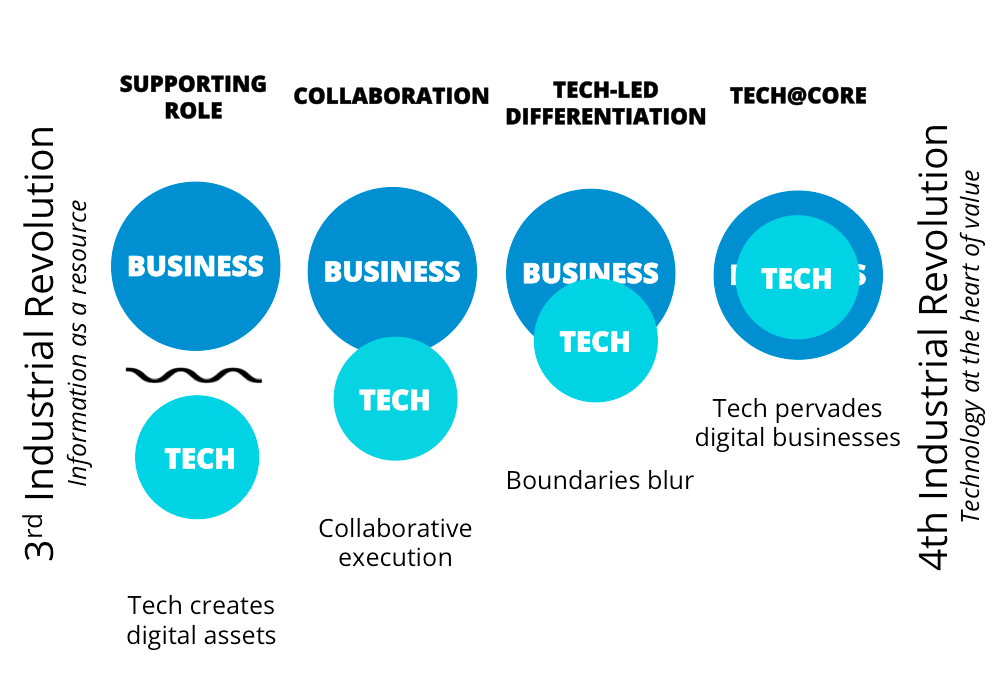
The seven tenets of new age business analysis
Published: November 02, 2018
The most radical period of change in industrial history is nearly upon us. Technology is evolving faster than humanity is able to keep up with it. There is now a need for rapid, sustained and growing innovation in what the World Economic Forum has dubbed the Fourth Industrial Revolution. The first industrial revolution brought in steam to mechanize power; the second brought in electricity to power mass production, and the third was the dawn of the information era with the rise of the internet. We are now at the cusp of the fourth revolution, where billions of people are connected to unlimited processing power and access to knowledge. This is the revolution where technology is at the heart of value.

This has massively transformed the way businesses are conceived and run. We are witnessing a drastic shift where digital technologies are moving from being enabling functions, to being at the core of business strategy. Three distinct types of businesses have evolved in the last decade:
What is common to these three type of businesses is the fact that technology is at the core of what they do.

There is a huge gap between the exponential growth of technology and organisations’ ability to harness it, and this gap is only going to increase with time. Gone are the days of siloed technology and business functions, and herein lies the opportunity.
Businesses will need to make systemic changes to be responsive to technology advancements, but the transformation will not happen overnight. This calls for a role to facilitate this change, and we believe that business analysts (BAs) are uniquely positioned to play this role.
To accomplish this, we believe that BAs will need to operate at two levels - that of execution and that of problem definition. Execution - or the build-measure-learn cycle - is important and relevant, as it is what puts products in the hands of users. This is the mode that most BAs are extremely comfortable in. Problem definition is where the opportunity awaits. It is here that the BA needs to take a step back from execution and look at where the overall solution needs to head. This is where one examines the latest that technology has to offer, understands the market, and deduces how to best leverage the technology to unlock the potential for new streams of revenue, new customer segments and better engagement. This is a cycle of blue sky thinking or ideation, assessment of opportunities, and evolution of the vision, to keep it relevant.


This might seem like a lot to ask of one function, but we believe that business analysis is most effective this way. For instance, Kevin Systrom - a connoisseur of whiskeys - built a location-based iPhone app called Burbn to check in at pubs, make plans with friends for future pub nights, and share pictures of the evening. The app didn’t do well in the market. As he studied each of the features closely and tweaked them for better adoption, he realized he needed metrics to assess what users liked and disliked most about the app. He brought in an analytics expert, and they found that most people weren’t using the app for what it was intended - check-ins, but were using it to post and share pictures. This, coupled with the advent of high-resolution phone cameras, led them to evolve the product to a photo-sharing app. That’s how Instagram was born.
To provide a starting point for BAs to make this shift, we’ve put together a set of tenets for new age business analysis. Like the Agile manifesto, our statements imply that two things are important, but the one on the left is more valuable than the one on the right.
Every individual is a combination of the traits they inherently have and the skills that they acquire. The Fourth Industrial revolution is so transformative that it has to be driven by individuals who exhibit both.

Organizations will have to meet individuals halfway. In order to pave the way for this change, employers and customers should hold BAs accountable for the value that they add to the end users and how well they’ve used technology as a business enabler. Innovation should be valued over delivery.
(Adapted from our talk.)

This has massively transformed the way businesses are conceived and run. We are witnessing a drastic shift where digital technologies are moving from being enabling functions, to being at the core of business strategy. Three distinct types of businesses have evolved in the last decade:
1. Physical, now digital
Traditional businesses have needed to own physical assets in order to provide any sort of services to end customers. With the onset of technology, establishments can deliver services without owning any assets. Take, for instance, traditional cable companies that relied on heavy physical infrastructure, which have now given way to Netflix-like products, satiating the current generation’s need for on-demand services.2. Digital native
We would not have known that we needed a FitBit till the technology for it came into existence. There is a whole class of businesses that have emerged around technological innovations. Startups are constantly on the lookout for technology disruptions and are crafting new products and business models that are rapidly becoming the new normal.3. Powering digital
Where would any of these digital businesses be without the firepower that organisations like Slack, Amazon Web Services, Hadoop and GitHub provide? The advent of digital businesses has spawned off a flurry of businesses whose sole purpose is to power other digital businesses.What is common to these three type of businesses is the fact that technology is at the core of what they do.

Over time, technology grows at an exponential rate. But businesses aren’t able to keep up fast enough.
There is a huge gap between the exponential growth of technology and organisations’ ability to harness it, and this gap is only going to increase with time. Gone are the days of siloed technology and business functions, and herein lies the opportunity.
Businesses will need to make systemic changes to be responsive to technology advancements, but the transformation will not happen overnight. This calls for a role to facilitate this change, and we believe that business analysts (BAs) are uniquely positioned to play this role.
BAs already have the innate ability to understand the landscape of businesses, and they understand technology well enough to know how it can solve problems.
This enables them to be change leaders as more businesses are modeled around technology.To accomplish this, we believe that BAs will need to operate at two levels - that of execution and that of problem definition. Execution - or the build-measure-learn cycle - is important and relevant, as it is what puts products in the hands of users. This is the mode that most BAs are extremely comfortable in. Problem definition is where the opportunity awaits. It is here that the BA needs to take a step back from execution and look at where the overall solution needs to head. This is where one examines the latest that technology has to offer, understands the market, and deduces how to best leverage the technology to unlock the potential for new streams of revenue, new customer segments and better engagement. This is a cycle of blue sky thinking or ideation, assessment of opportunities, and evolution of the vision, to keep it relevant.


This might seem like a lot to ask of one function, but we believe that business analysis is most effective this way. For instance, Kevin Systrom - a connoisseur of whiskeys - built a location-based iPhone app called Burbn to check in at pubs, make plans with friends for future pub nights, and share pictures of the evening. The app didn’t do well in the market. As he studied each of the features closely and tweaked them for better adoption, he realized he needed metrics to assess what users liked and disliked most about the app. He brought in an analytics expert, and they found that most people weren’t using the app for what it was intended - check-ins, but were using it to post and share pictures. This, coupled with the advent of high-resolution phone cameras, led them to evolve the product to a photo-sharing app. That’s how Instagram was born.
To provide a starting point for BAs to make this shift, we’ve put together a set of tenets for new age business analysis. Like the Agile manifesto, our statements imply that two things are important, but the one on the left is more valuable than the one on the right.
1. Creation and measurement of value over Carrying out a release plan
We often measure effectiveness by the timeliness of delivery. While that is important, creation and measurement of value should take precedence. When we are held accountable for value, then we build what’s most effective rather than what’s been written in a plan.2. User-centricity over Business objectives
There’s often a tussle between business targets and user experience. For instance, operational efficiency is often prioritised over customer engagement. We’ve seen teams overengineer admin portals, believing that it will amplify impact to the business, without fully understanding what value they add and who they are built for. This leads to a fragmented solution which is cumbersome to use and train in, and in effect, fruitless.3. Dynamic roles over Single responsibilities
As time passes, role boundaries as we know them will be obsolete. The need of the hour will be to step into the shoes of anyone that is required to get the job done. BAs will need to put on many hats - that of an experience designer, of a project manager, of a quality analyst, of a salesperson and many more. Versatility will be a much-coveted trait.4. Being enablers for business-focused teams over Being proxy business representatives
For too long now, BAs have called themselves the proxy product owners and have relayed decisions from business teams to development teams. Development teams have focused on executing specs. However, as technology embeds itself firmly in business, all roles will need to work towards business outcomes. The BA will play the critical role of being an enabler.5. Big picture thinking over Focusing on the details
BAs excel at fleshing out details of features, an important skill that will always be relevant. But, much like Kevin Systrom, BAs will need to step back and look at the whole solution ecosystem, not just the software.6. Meaningful conversations over Requirement elicitation
Engagement with stakeholders will have to be elevated to the next level. Transactional elicitation needs to be replaced with deeper observations and conversations. The aim is to question, challenge and empathise to deduce how to build the right thing, over what’s been signed off in a spec.7. Application of technology over Technology awareness
In this world of emerging technology, BAs can no longer afford to shy away from all that’s technical. We will instead need to immerse ourselves in it, to the point that we can recommend how to harness it most effectively for businesses to succeed. BAs will, in this way, move up the value chain.Every individual is a combination of the traits they inherently have and the skills that they acquire. The Fourth Industrial revolution is so transformative that it has to be driven by individuals who exhibit both.

Organizations will have to meet individuals halfway. In order to pave the way for this change, employers and customers should hold BAs accountable for the value that they add to the end users and how well they’ve used technology as a business enabler. Innovation should be valued over delivery.
(Adapted from our talk.)
Disclaimer: The statements and opinions expressed in this article are those of the author(s) and do not necessarily reflect the positions of Thoughtworks.









